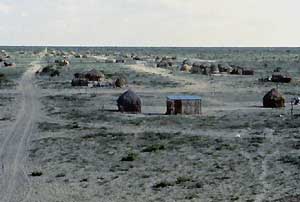| Period: 18 October - 18 November 2003. Country: Ethiopia, Kenya,
South Africa, Botswana, Namibia |
| |
Purpose of the Visit |
| |
Participation in International Workshop and Study Tour
in cooperation with field station in Ethiopia, field station operation and
on-site education in Kenya, on-site education in Botswana, research in South
Africa, Botswana and Namibia |
| |
TANAKA Jiro (ASAFAS: Division
of African Area Studies) |
| |
Record of Activities |
| |
10/18 (Sat) – 10/19 (Sun) |
 |
Leave Kansai Airport – Arrive in Nairobi |
| |
10/20 (Mon) |
 |
Leave Nairobi – Arrive in Addis Ababa |
| |
10/21 (Tue) – 27
(Mon) |
 |
Participate in 21st Century COE program workshop held at Addis
Ababa University and study tour |
| |
10/28 (Tue) |
 |
Leave Addis Ababa – Arrive in Nairobi |
| |
10/29 (Wed) – 11/1 (Sat) |
 |
On-site education in Nairobi |
| |
11/2 (Sun) |
 |
Leave Nairobi – Arrive in Johannesburg |
| |
11/3 (Mon) |
 |
Make various arrangements and conduct liaison work,
collect materials in Johannesburg |
| |
11/4 (Tue) |
 |
Leave Johannesburg – Arrive in Gaborone |
| |
11/5 (Wed) – 10 (Mon) |
 |
Survey on the Bushmen in Xade area area and on-site
education |
| |
11/11 (Tue) |
 |
Leave Xade area – Arrive in Windhoek |
| |
11/12 (Wed) – 15
(Sat) |
 |
Survey of Bushmen rock paintings in Khorixas area |
| |
11/16 (Sun) |
 |
Leave Khorixas area – Arrive in Johannesburg |
| |
11/17 (Mon) – 18 (Tue) |
 |
Leave Johannesburg – Arrive at Kansai Airport |
| |
Outcome
and Progress Report |
| |
In Kenya, at the field station set up in Nairobi city, I met
a graduate Student of ASAFAS, Mr. Naoki Naito (year of enrollment: 1999) to
have discussions together with Itaru Ohta (ASAFAS faculty) on methods for surveys
and problems related to his research on pastoral people in the dry zone of
northern Kenya.
Mr. Naito is conducting
ecological and anthropological studies on the Ariaal, who live in the semi-arid
Marsabit district. While elucidating their environmental
awareness and livelihood structure, he is studying their ethnic identity by
observing their relations with two other peoples, the Samburu and the Rendille,
and the details of the negotiations between these groups.
In Botswana, I visited
the study site of another student of ASAFAS, Ms. Junko Maruyama (year of enrollment:
2000), at the New Xade resettlement site for
Central Kalahari Bushmen, which was established in 1997. I discussed problems
and the method of her survey with her.
Ms. Maruyama has
been surveying the livelihood and behavior of people in a process of transition
from
a
nomadic hunter-gatherer lifestyle to a settled
cash economy lifestyle at a government-led resettlement, based mainly on anthropological
participant observation. From now on, she is planning to carry out comparative
studies in two or three
other settlements in the area, and complete her doctoral dissertation. |
 |
|
 |
| Stela
(stone pillar) at the ancient Ethiopian capital of Axum. |
|
View of
the resettlement camp of New Xade |
|
|
 Report
Report